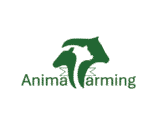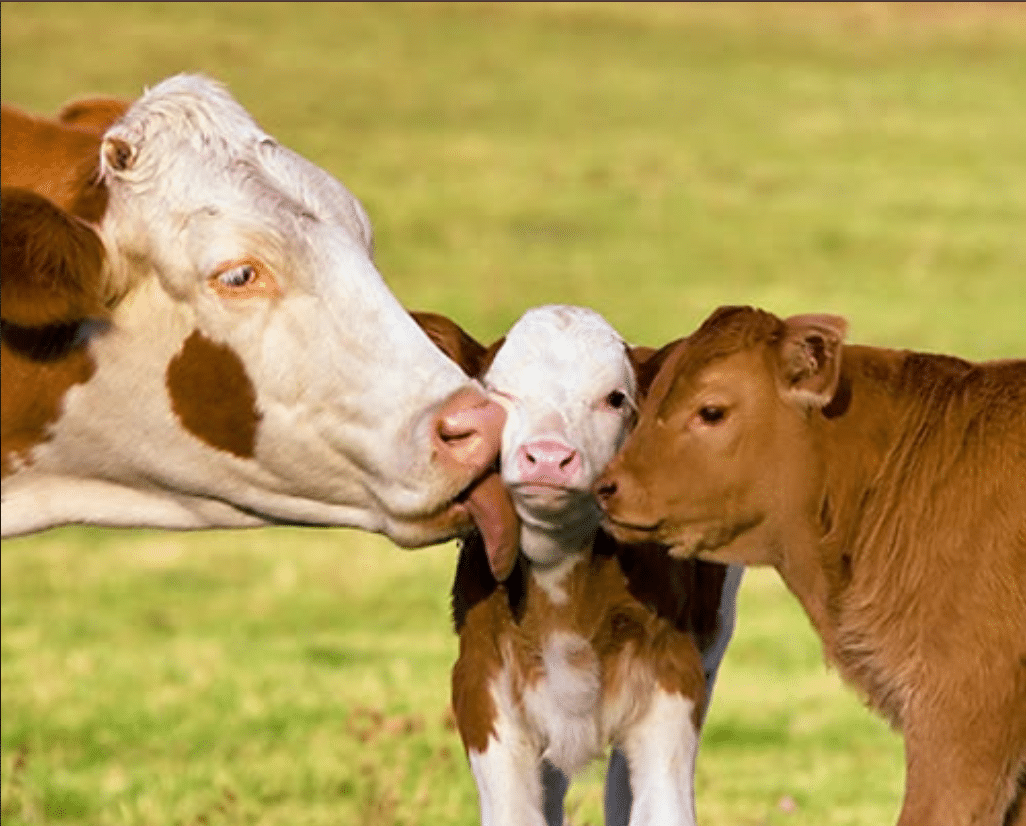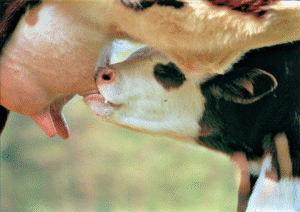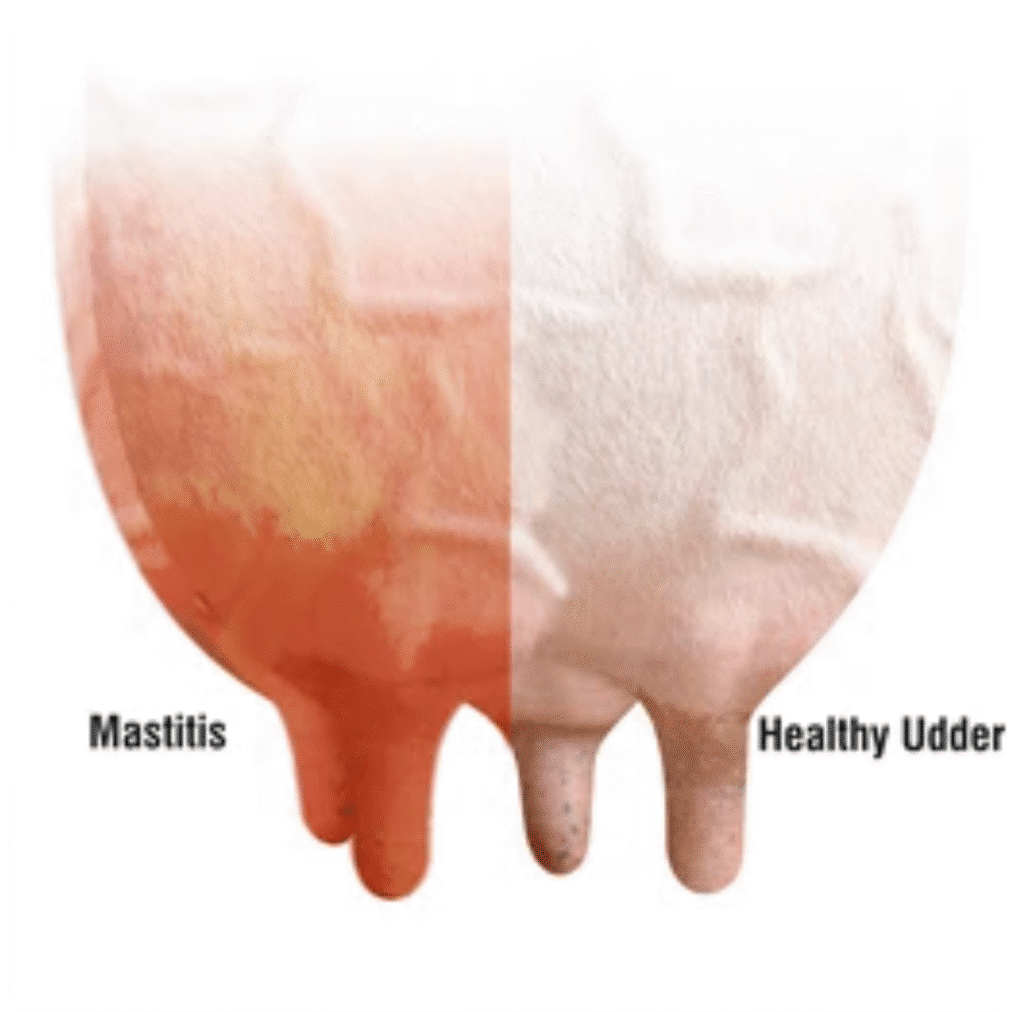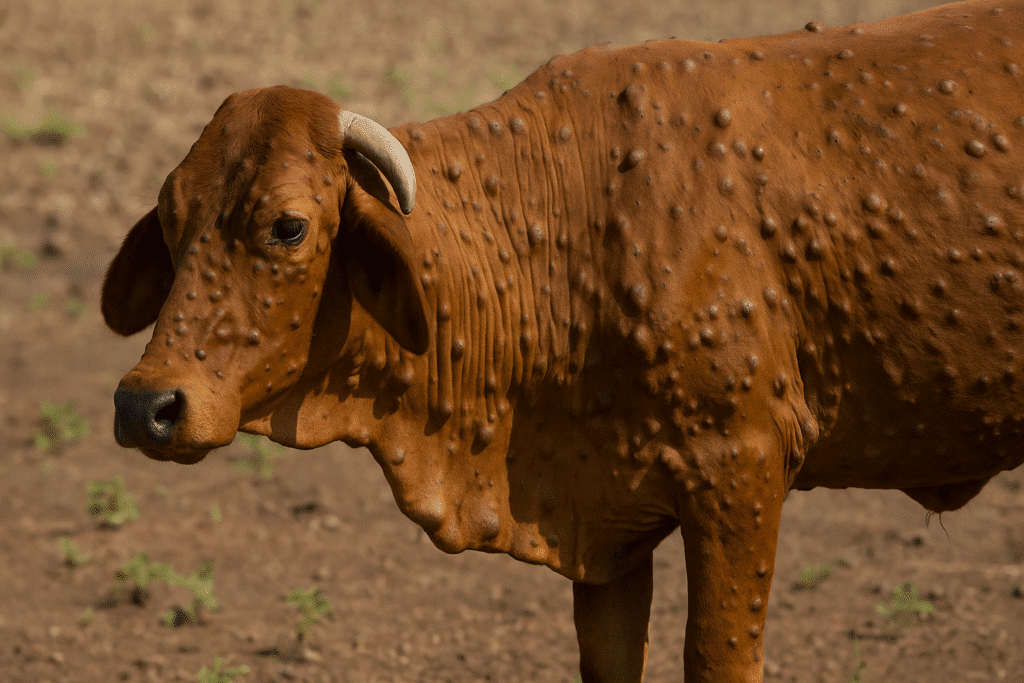Scours in calves (meaning diarrhea in young calves) occurs when a calf passes loose, watery stool repeatedly. Diarrhea in calves causes rapid fluid loss (water and salts), leading to dehydration, weakness, dullness, and sometimes even death. Normally, manure contains about 25% solids, but with scours, it can have more than 80% water. If not treated quickly, scours can be fatal. It most often occurs in the first few weeks of life.
Scours in calves can develop from infectious causes or from non-infectious causes. The same is true for scours in lambs, which also arises from both infectious and non-infectious factors. In all cases, the intestines stop working properly, fluids are lost in watery dung, and the calf cannot absorb enough nutrients. This makes scours one of the most serious health problems for young calves Therefore, early management and prevention can help save a calf by minimizing serious illness and reducing the risk of death.
Signs of Scours in Calves
The common sign of scours in the calf is watery stool like yellow, brown, gray or green in color, dehydration and weakness. Diarrhea (watery stool) happens because the intestine fails to absorb water and nutrients properly. Stool may turn yellow, green, white, or sometimes contain blood, depending on the germ involved or the level of gut damage. For instance, calf’s yellow poop is common, while the presence of blood in calf poop shows severe injury to the gut lining. The manure often carries a strong, foul smell due to bacterial activity. In these early stages, calves typically drink less milk, appear dull, and become less active as they start to lose energy.
As the disease progresses, symptoms of dehydration become clear. The calf’s eyes appear sunken. The nose and mouth feel dry, and when the skin on the neck is pinched, it takes longer to return to normal. The calf also urinates less as its body tries to conserve water. With ongoing fluid loss, the calf grows thinner and weaker, often spending more time lying down and struggling to stand.
In severe cases, blood circulation becomes weak, leading to cold legs and sometimes a cow with droopy ears. The scouring calf may start breathing faster as the body struggles to correct salt imbalances in the blood. At this stage, symptoms of calf scours include extreme weakness, dullness, and, in some cases, the calf may no longer be able to stand. If left untreated, scours can lead to shock and death.
What causes scours in calves?
Scours in calves is caused by poor, unhealthy, and dirty nutrition or milk, with viruses and bacteria also being major contributors. Calf scours can be developed by two main factors: infectious and non-infectious. Infectious scours happens when viruses, bacteria, or parasites attack the calf’s intestines, leading to diarrhea. Non-infectious causes are linked to management issues like poor feeding, irregular milk schedules, wrong milk temperature, or improper mixing of milk replacer. In many cases, both types of causes work together, making the condition more severe.
Non-Infectious Causes
Poor Colostrum Intake
One of the most critical causes of scours is poor colostrum intake. Calves that fail to receive enough high-quality colostrum within the first few hours after birth develop weak immunity. Without these vital antibodies, calves are much more likely to develop scours and other infections in their early days.
Poor Hygiene
Dirty pens, damp bedding, and unclean feeding equipment create a breeding ground for germs. Even healthy calves can quickly develop scours when exposed to such unhygienic conditions, as disease-causing organisms spread rapidly from manure to the calf.
Overfeeding Milk
Feeding more milk than the calf’s stomach can handle often results in indigestion. This leads to sudden watery diarrhea, sometimes with a visibly swollen belly after feeding. Overfeeding weakens digestion and increases the calf’s susceptibility to infections.
Sudden Feed Changes
A sudden change in milk replacers or introducing solid feed too early can upset the calf’s digestive system. The gut struggles to adapt, which results in loose manure and poor absorption of nutrients.
Cold and Stress
Environmental stressors such as cold, wet bedding, overcrowding, or long transport weaken a calf’s natural defenses. A stressed calf’s body cannot fight off germs effectively, making scours more likely and allowing it to progress rapidly.
Infectious Causes
E. coli
E. coli is a bacterium that commonly causes scours in newborn calves within the first four days of life. It attacks the intestine, releasing toxins that damage the gut lining and disrupt normal absorption of water and nutrients. E. coli spreads easily through contaminated manure, dirty bedding, feeding equipment, and poor hygiene, with calves that lack proper colostrum intake being most vulnerable.
Rotavirus
Rotavirus is a common virus that causes scours in calves between 5 and 14 days of age. It attacks the cells lining in small intestine, damaging the villi that absorb nutrients and water. As a result, undigested feed stays in the gut, drawing water into the intestine and leading to watery yellow diarrhea.
Rotavirus spreads quickly through manure, bedding, and feeding equipment, especially in dirty conditions, and calves with poor colostrum intake are most at risk due to weak immunity.
Coronavirus
Coronavirus usually affects calves between one and three weeks of age. It targets the small intestine, damaging both the villi and intestinal crypts, which are essential for nutrient and water absorption. Unlike rotavirus, it can also affect the large intestine, causing even greater fluid loss.
This leads to severe and longer-lasting diarrhea that may sometimes contain blood and often has a strong foul smell due to undigested material fermenting in the gut. As a result, calves lose nutrients quickly, become weak, and recover slowly, even with supportive care, making dehydration a serious risk.
Cryptosporidium
Cryptosporidium is a parasite (protozoa) that commonly infects calves between 1-3weeks of age. It attaches to the cells lining of small intestine, which results in damaging the villi responsible for nutrient and water absorption. This causes persistent watery diarrhea, poor digestion, and weakness, often leading to delayed growth.
This parasite spreads through highly infectious oocysts present in feces, bedding, water, and feeding equipment, and calves with weak immunity or poor colostrum intake are most at risk. Supportive care with hydration and electrolytes is critical, as Cryptosporidium is resistant to many medications.
Coccidia
Coccidia, caused by Eimeria species, is a parasite (protozoan) that usually affects calves older than three weeks. It infects the cells lining of small and large intestines, causing bloody diarrhea, straining, and inflammation.
This damages nutrient and water absorption, leading to weight loss, poor growth, dehydration, and weakness. The parasite spreads through hardy oocysts in feces that contaminate bedding, feed, and water, and calves with weak immunity or poor colostrum intake are most at risk.
Treatment calf scours
The main treatment for calf scours is to replace lost fluids, restore electrolytes, and provide energy and nutrition. All calves with scours need electrolytes. Mild cases may recover with oral electrolytes alone, while severely dehydrated calves may require fluids given intravenously by a veterinarian. Energy and nutrition, especially from milk, are essential for recovery. Milk should not be withheld for long, and sometimes milk and electrolytes need to be given separately.
Below are the simple treatment steps and remedies that farmers can use to manage scours in calves effectively. Remember, in severe conditions, get the help of a veterinary doctor.
Fluid Therapy
Fluid therapy is the most important step in treating scours because it replaces the water and salts lost during diarrhea. This helps the calf regain balance and prevents death from dehydration. The best way to treat calf scours is with oral electrolyte solutions. These special solutions contain the right mix of salts and sugars, which allows the calf’s body to absorb fluids properly.
Plain water is not enough, as it cannot replace the lost salts. A scouring calf usually needs about two liters of electrolytes at a time, which can be given several times a day depending on how severe the diarrhea is. Electrolytes should always be given in addition to milk, but never at the same time. Keeping a gap ensures the calf gets both energy from milk and rehydration from electrolytes.
If the calf is too weak to drink from a bottle, the solution can be given through a stomach tube. Farmers should always use the best electrolytes for calves as recommended by a veterinarian and follow the mixing directions exactly. A solution that is too strong or too weak can make the calf worse.
Nutritional Support
Nutritional support is vital in treating scours in calves. While electrolytes replace water and salts, they cannot provide the protein and energy needed for healing. Milk feeding supplies these nutrients, keeping the calf strong, maintaining weight, and speeding up recovery. Without milk, calves become weak, lose condition, and take longer to heal.
- Daily Milk Requirement: Feed about 10% of body weight in milk daily.
Example: A 40 kg calf needs about 4 liters per day.
- Feeding Schedule: Give milk as 2 liters twice daily (morning and evening). Weak calves may benefit from smaller, more frequent feeds.
- Milk Temperature: Always feed milk warm, between 37–39 °C (body temperature). Cold milk slows digestion, while very hot milk damages proteins and upsets the stomach.
- Electrolytes: Oral electrolytes should be given between milk feedings, never mixed. Leave a 2–3 hour gap between milk and electrolyte feeds.
- Milk Type: Whole milk is best for scouring calves. If not available, use a high-quality milk replacer. Always mix replacers exactly as instructed — never stronger or weaker.
This balanced feeding plan ensures proper calf with scours treatment, because milk provides protein and energy while electrolytes restore lost water and salts. Together, they form the foundation of successful scours treatment in calves.
Calf Scours Antibiotics
Antibiotics are only used when a scouring calf is very sick and the infection has spread beyond the gut into the whole body. Most cases of scours in calves do not need antibiotics, but they may be lifesaving when the infection is severe. A veterinarian should always guide the choice of calf scours medication or calf scour treatment products, as misuse can cause resistance.
A calf may need calf scours antibiotics if it shows any of the following:
- High fever – calf feels very hot (temperature above 39.5 °C / 103 °F).
- Bloody diarrhea – fresh blood or very dark, tarry dung.
- Extreme weakness or dullness – calf lies down most of the time and struggles to stand.
- Refusal to drink – calf loses its suck reflex and will not take milk or electrolytes.
- Cold ears and legs with sunken eyes – signs of severe dehydration and spreading infection.
- Other infections present – such as swollen joints, coughing, or pneumonia, along with scours.
Antibiotics like Oxytetracycline, Sulfadiazine, and Amoxicillin are used for the treatment of scouring in calves. Here is the use of the following antibiotics.
- Oxytetracycline – A broad-spectrum antibiotic often used for weak calves. It is widely available as an injection and works against many bacteria.
- Sulfa drugs (such as sulfadimidine or trimethoprim-sulfamethoxazole) – Useful for gut infections and also for blood infections in scouring calves. Available as oral drenches or injections. Often sold as scour tablets or scour pills for calves.
- Amoxicillin – A reliable antibiotic for very sick calves where infection has spread beyond the gut. Safe when dosed correctly by injection.
Home Remedies for Calf Diarrhea
Calves scouring can be treated by home remedies like clean water, salt, rice water, baking soda and sugar. Some farmers use calf diarrhea home remedies along with normal treatment to help calves recover. These remedies are simple, low-cost, and can support the calf’s gut health and energy:
- Homemade Electrolyte Solution
Start by giving a homemade mix of clean water, salt, baking soda, and sugar. This keeps the calf hydrated and replaces what is lost through scours.
- Rice Water
After that, give the calf rice water made from boiled rice. It soothes the stomach and helps slow down fluid loss.
- Yogurt or Probiotics
When the calf starts to recover, you can give plain yogurt or probiotics to restore healthy gut bacteria and support better digestion.
- Honey or Molasses Water
If the calf is weak, give a small amount of honey or molasses mixed in warm water. This provides quick energy and helps regain strength.
- Herbal Teas
Small amounts of mild chamomile or fennel tea can be used to ease stomach pain and support recovery.
- Clean and Warm Environment
Throughout the treatment, keep the calf in a clean, dry, and warm space. This reduces stress and prevents new infections.
These home remedies can support recovery, but they should never replace electrolytes, milk feeding, or veterinary care.
Prevention of Calf scours
Preventing scours in calves is always better than treatment. Scours causes sickness, poor growth, and even death in young calves, while treatment is costly and time-consuming. The best protection comes from a healthy cow, a clean environment, good colostrum, and proper calf care. Acting early can save a calf before the condition becomes life-threatening.
Preparing Before Calving
Prevention of scours starts well before calving. During pregnancy, cows need diets that supply enough protein, minerals, and energy to support both the unborn calf and the production of quality colostrum.
Vaccinating cows 6–8 weeks before calving against E. coli, rotavirus, and coronavirus increases antibody levels in the colostrum, which then provides calves with early protection. Farmers can also speak with a veterinarian about Bovatec, a product that helps limit the spread of certain diseases within the herd.
Clean Calving Environment
The next priority is maintaining excellent hygiene. Calving pens should be dry, well-bedded, and never overcrowded. Feeding equipment such as buckets and bottles must be washed and disinfected regularly. Separating heifers from older cows also reduces the chance of disease transfer. A clean, dry environment lowers the risk of a cow with diarrhea passing germs to newborn calves.
Colostrum Management
Colostrum is the calf’s first and strongest defense. Each calf should drink at least 4 liters of colostrum within 2 hours of birth, and additional colostrum within the first 12 hours.
If natural colostrum is unavailable, high-quality colostrum replacers should be provided. Calves can be more exposed to scours and have weak immunity if sufficient colostrum is not provided.
Feeding Practices After Birth
After colostrum feeding, proper milk feeding management is critical to calf health. Many cases of milk scours in calves result from errors like irregular feeding, milk served too hot or cold, or poorly mixed replacers. To avoid this:
- Feed at the same time every day.
- Mix replacers correctly according to instructions.
- Serve milk warm, close to body temperature.
Monitoring and Isolation
Despite good prevention, a few calves may still come down with scours. Farmers need to check calves every day for early signs like watery manure, sunken or dull eyes, and weakness. Any calf showing these symptoms should be separated right away to prevent the illness from spreading to the healthy group.
Grouping calves by age also reduces disease spread, since older calves can transmit infections more easily to younger ones. Systems like the Sandhills Calving Method are very effective in lowering scours cases.
Vaccination Against calf Scours
Finally, vaccination offers lasting protection. Cows and heifers should receive their shots 3–8 weeks before calving so that antibodies are passed into the colostrum.
Replacement heifers usually need a full vaccination course earlier in life, followed by a booster before their first calving. Store vaccines properly and give them with clean equipment to ensure they work effectively.
Conclusion
Scours in calves remains one of the most serious health threats in young cattle. Farmers can manage it effectively through prevention, early diagnosis, and timely treatment.
Understanding the causes both infectious and non-infectious, helps guide accurate testing and appropriate care. Treatment mainly involves replacing lost fluids, giving supportive products, and using antibiotics only when needed.
Prevention relies on strong colostrum management, clean calving areas, proper feeding, and timely vaccination. With good hygiene, daily calf checks, and quick isolation of sick animals, farmers can greatly cut losses from scours and raise healthier herds.
Calf Scours Frequently Asked Questions
What is scours in calves?
Scours (Diarrhea) in calves means loose or watery feces. It is a condition that causes rapid loss of fluids and electrolytes, leading to dehydration and weakness.
What causes scours in calves?
Scours in calves is caused by poor, unhealthy, and dirty nutrition or milk, with viruses and bacteria also being major contributors. Calf scours has two main types of factors: infectious and non-infectious.
How to treat diarrhea in calves?
Diarrhea in calves is treated by replacing lost fluids with electrolytes, providing proper nutrition through continued milk feeding. In severe cases, administering intravenous fluids under veterinary care. Antibiotics may be used if a bacterial infection is confirmed.
What to give a calf with scours?
A calf with scours should be given oral electrolytes to replace lost fluids and salts, along with regular milk feedings for energy and nutrition. In severe cases, a veterinarian may need to give intravenous fluids or prescribe specific medications.
How to prevent scours in calves?
Farmers can prevent scours in calves by giving them good colostrum soon after birth, keeping housing clean and dry, providing proper nutrition, and maintaining strict hygiene in feeding and handling. Vaccinating cows before calving can also help protect calves from common infectious causes.
What causes bloody scours in calves?
Bloody scours in calves is usually caused by severe intestinal infections, mostly from bacteria like E. coli, Salmonella, or Clostridium perfringens. These pathogens damage the gut lining, leading to blood in the diarrhea.
